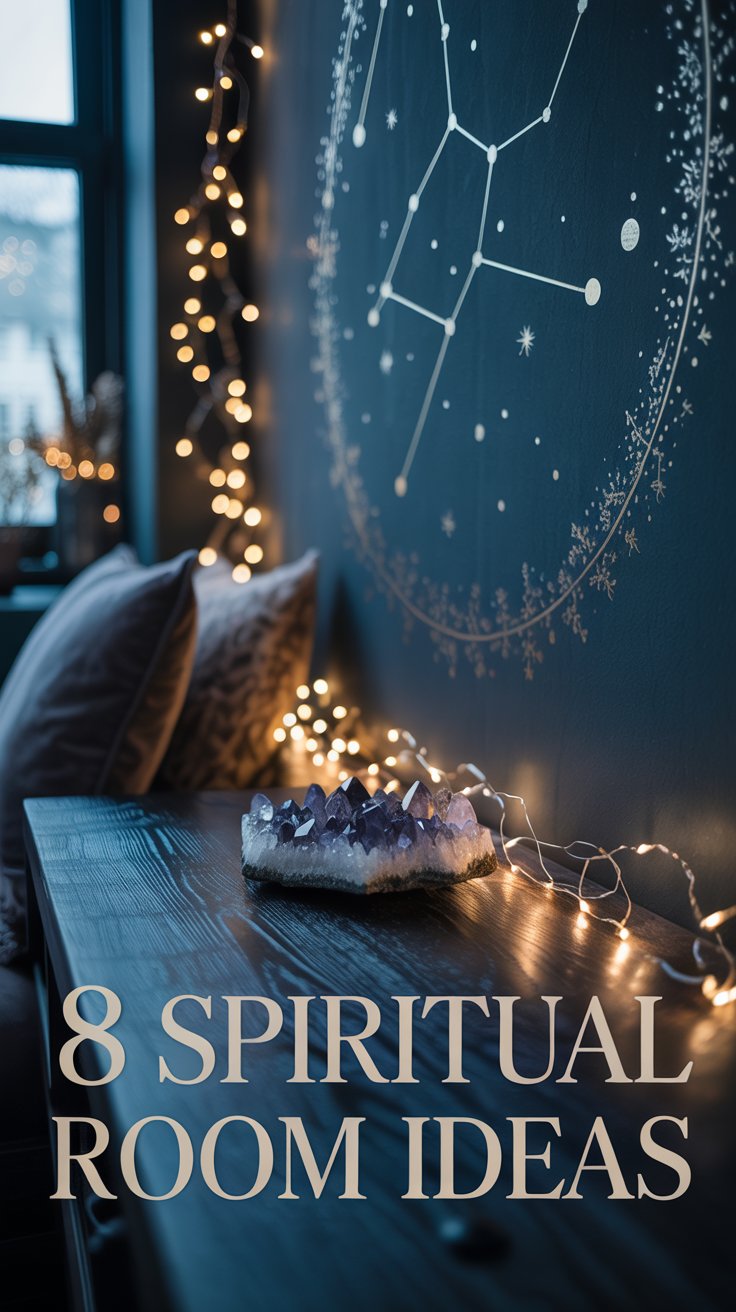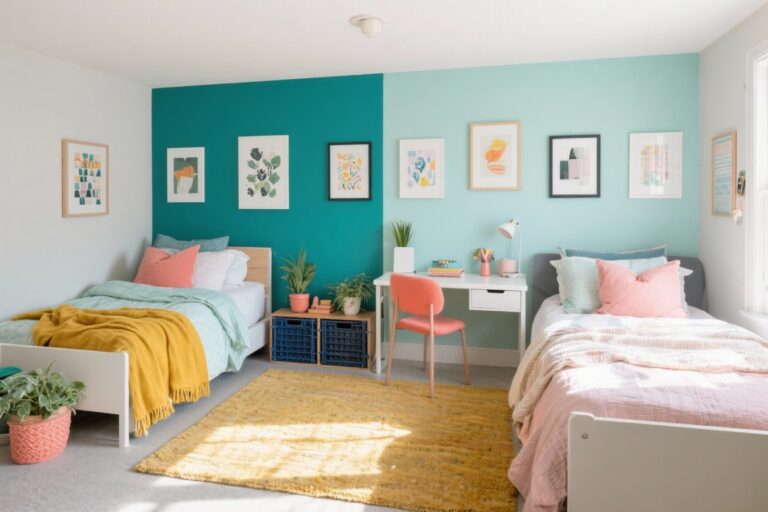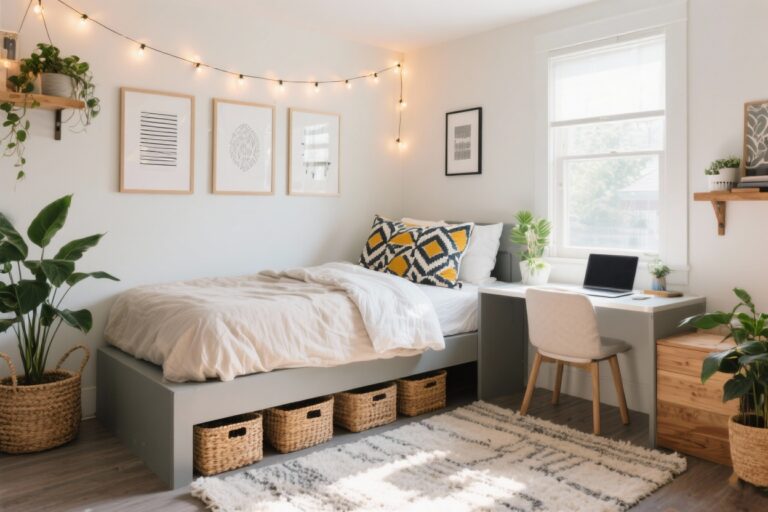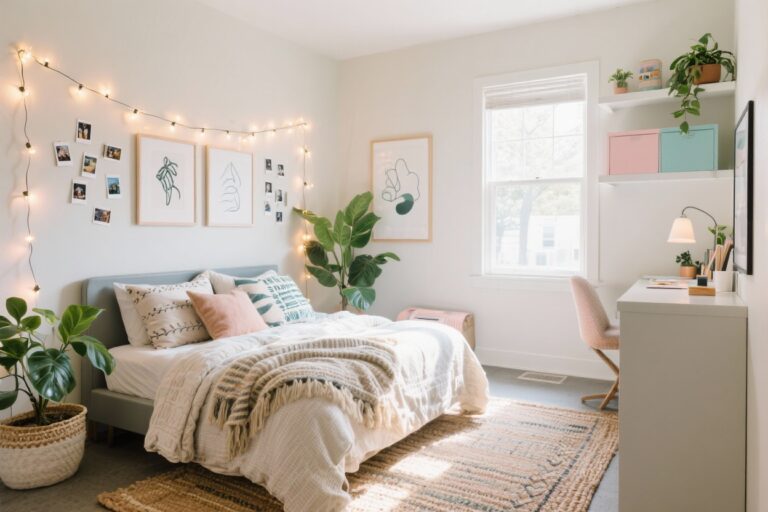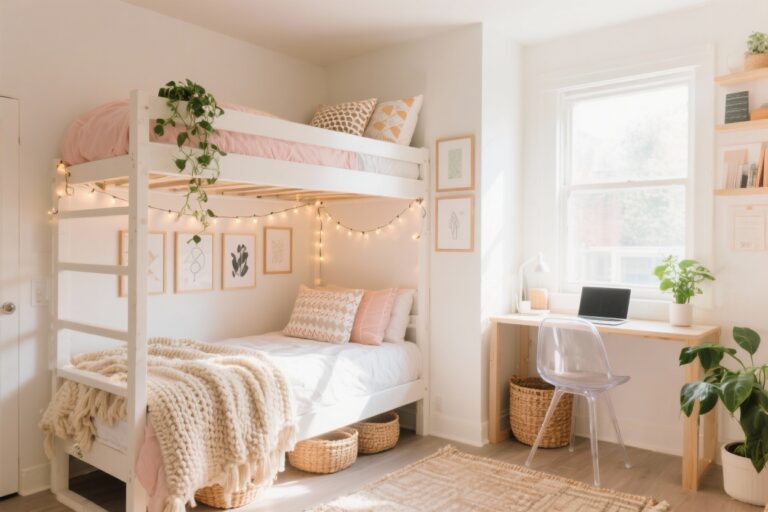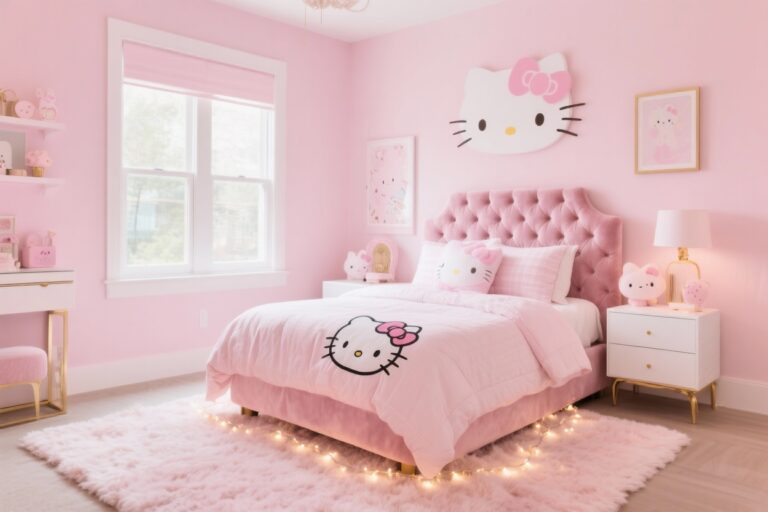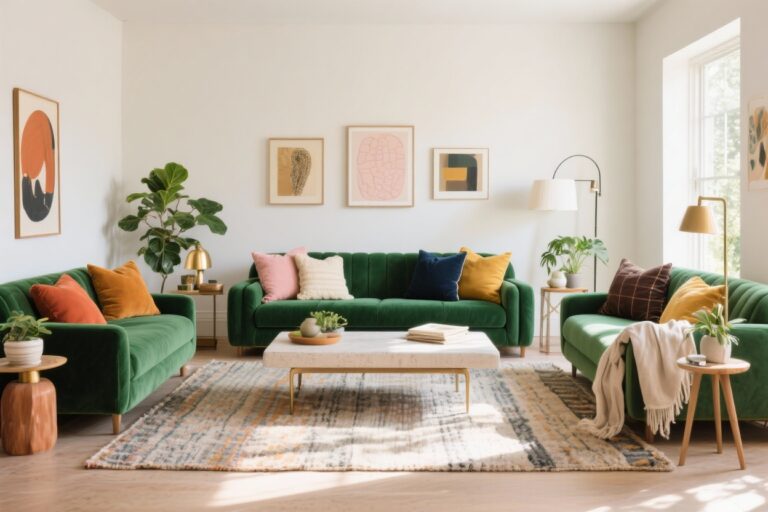In our bustling, always-on world, the desire for a personal sanctuary has never been more profound. We crave a space that is more than just four walls and a roof; we need a haven where we can exhale, reconnect with our inner selves, and quiet the noise of daily life. Creating a spiritual room isn’t about subscribing to a specific creed or doctrine; it’s a beautiful act of self-care, an interior design project for the soul. It’s about curating an environment that reflects and nurtures your unique spirit, a place where you can simply be.
Drawing from years of experience in fashion, interiors, and gardening, I’ve learned that the most resonant spaces are those that engage all our senses. The way a raw silk cushion feels against the skin, the calming effect of a monochromatic color palette, the life-affirming presence of a thriving plant—these elements are the building blocks of atmosphere. A spiritual space is the ultimate expression of personal style, blending the textures and colors you love with the natural elements that ground you, creating a narrative of peace that is entirely your own.
This guide is designed to inspire you with eight distinct visions for your sacred space. Whether you’re a minimalist at heart, a bohemian wanderer, or a lover of lush greenery, there’s a path here for you. Think of these not as rigid rules, but as optimistic starting points. We’ll explore how to blend light, color, natural materials, and personal treasures to design a room that not only looks beautiful but feels like a true extension of your spirit.
1. The Urban Biophilic Sanctuary
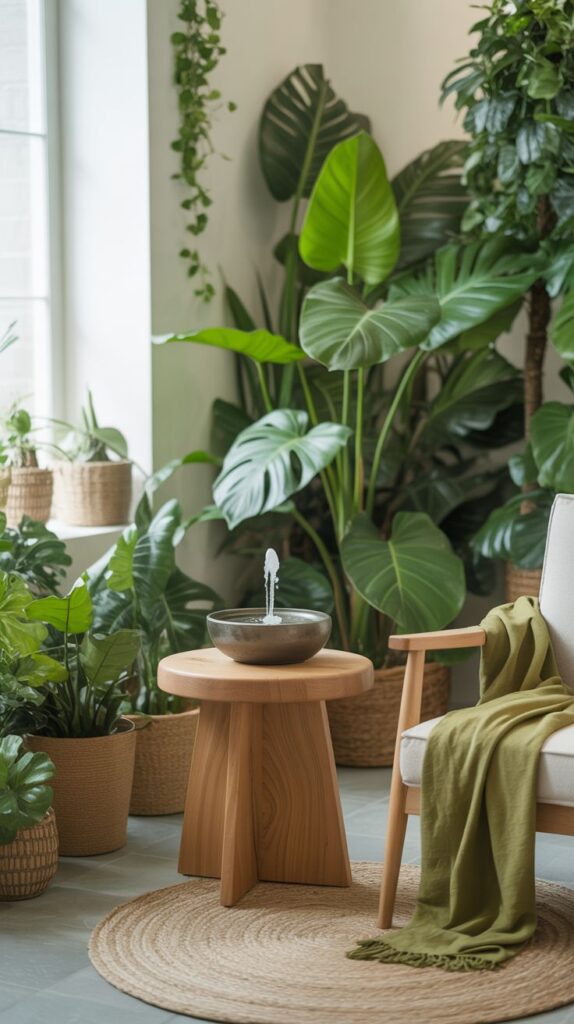
This vision is for the soul who finds spirituality in the living, breathing world. It’s based on the principle of biophilia—our innate tendency to seek connections with nature. This room is less of a decorated space and more of a cultivated ecosystem, designed to blur the lines between indoors and out. It’s a lush, green haven that reminds you of growth, resilience, and the quiet, steady pulse of life, even in the heart of the city. The goal is to create a space that feels alive, purifying the air and calming the mind with its vibrant, natural energy.
For the details, think abundant and varied plant life. A large, architectural Fiddle Leaf Fig or Monstera can create a stunning focal point, while shelves filled with trailing Pothos, Snake Plants, and unique Calatheas add layers of texture and green. Incorporate natural materials in their most honest forms: an unfinished oak bench, a water feature with smooth river stones, or a jute rug underfoot. Lighting should be bright and airy, maximizing natural sunlight. For textiles, choose natural fibers like cotton and linen in earthy tones of moss green, rich soil brown, and cloudy sky grey to complement the foliage.
Ultimately, the Biophilic Sanctuary becomes a testament to the restorative power of nature. It’s a room where you can practice mindfulness by simply observing the unfurling of a new leaf or listening to the gentle gurgle of water. It’s a daily reminder of your connection to the planet. This isn’t just decorating; it’s a form of indoor gardening that nurtures your environment and your spirit in equal measure.
2. The Minimalist Zen Retreat
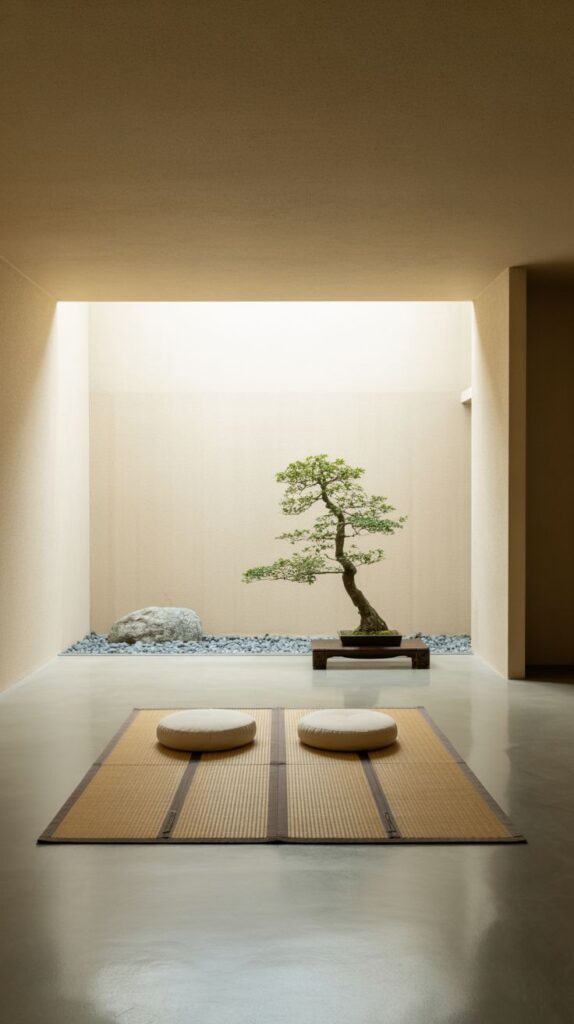
This space is an ode to clarity, designed for the individual who finds peace in simplicity and order. The guiding principle here is “less is more,” where every object has a purpose and a place, allowing the mind to become equally uncluttered. This isn’t about stark emptiness but about intentionality and the beauty of negative space. It’s a serene, quiet room that encourages meditation, deep thought, and a release from the sensory overload of the outside world. It’s the physical embodiment of a deep, calming breath.
To achieve this, focus on a restrained and harmonious palette. Think shades of cream, warm beige, soft grey, and muted stone. Furniture should be simple, low-profile, and crafted from light-colored wood like ash or maple. A low platform for meditation cushions, a single, beautifully crafted shoji screen to diffuse light, or one perfect piece of abstract art are all you need. Storage is key—it should be clever and concealed to maintain the pristine aesthetic. Texture, so important in fashion, prevents minimalism from feeling cold; introduce a single cashmere throw, a hand-thrown ceramic vase, or the subtle grain of a wooden floor.
The Minimalist Zen Retreat is a powerful statement about what you truly value. By stripping away the excess, you create a visual silence that allows your inner voice to be heard more clearly. It’s a highly disciplined yet deeply liberating style that proves a room doesn’t need to be full to make you feel whole. This is a sanctuary built on the foundation of focus and tranquility.
3. The Hygge Haven of Serenity
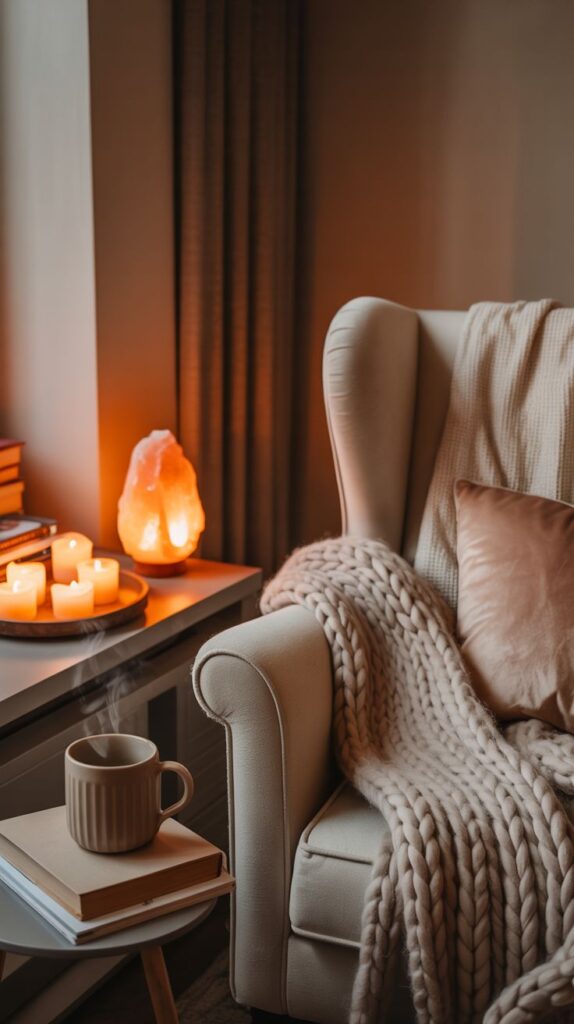
Inspired by the Danish concept of “hygge,” this room is a warm embrace, a sanctuary of coziness, comfort, and contentment. It’s for the soul that is nourished by warmth, softness, and the simple pleasures of feeling safe and cherished. This isn’t about grand gestures but about creating an atmosphere of gentle, unassuming comfort. It’s the feeling of being curled up with a good book on a rainy day, sipping a warm drink, and feeling completely at peace with the world.
The key to a hygge haven is layering textures and warm lighting. Forget harsh overhead lights; opt for a multitude of softer sources like table lamps with fabric shades, floor lamps, and an abundance of candles (or high-quality LED equivalents). Textiles are the star here. Think chunky knit blankets, faux fur throws, plush velvet cushions, and a soft, high-pile wool rug. The color palette is warm and inviting—creamy whites, soft caramels, muted rose, and dove grey. Furniture should be comfortable and inviting, like an overstuffed armchair or a small chaise lounge perfect for tucking your feet up.
This haven is a direct counterpoint to the stress of modern life. It’s a space that actively encourages you to slow down, relax, and practice self-compassion. Every element, from the scent of a vanilla candle to the feel of a soft blanket, is chosen to soothe the senses and create a feeling of profound well-being and intimate joy.
4. The Celestial Dreamer’s Nook
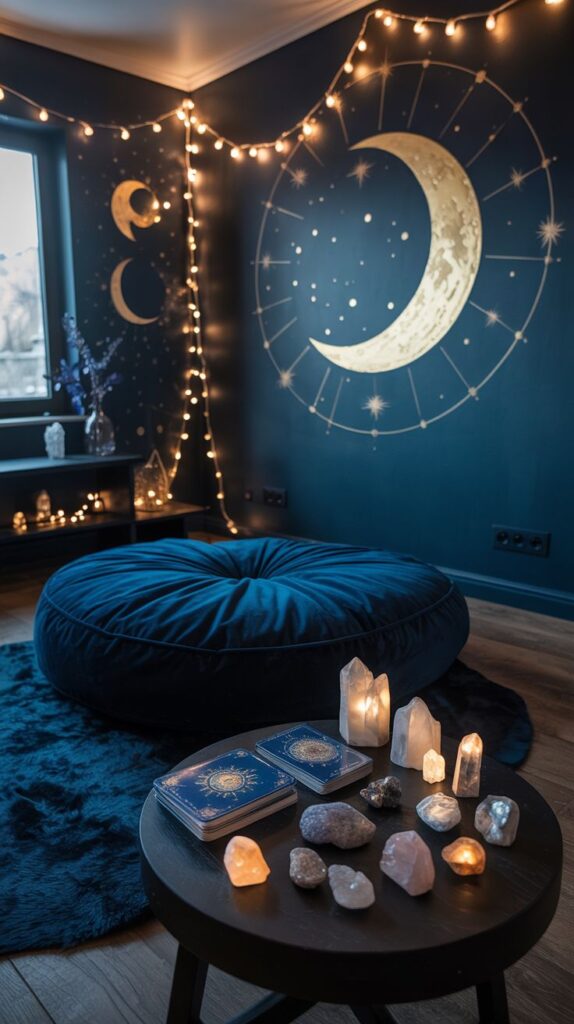
This vision is for the mystic, the stargazer, and the soul who feels a deep connection to the cosmos. It’s a space that honors the magic of the universe, the cycles of the moon, and the wisdom of the stars. The room becomes a personal observatory for the spirit, filled with elements that inspire wonder, intuition, and a sense of connection to something vast and beautiful. The palette is deep and enchanting, creating a womb-like environment for dreaming, divination, or meditation.
To bring this celestial nook to life, embrace a palette of midnight blue, deep indigo, charcoal grey, and flashes of silver and gold. One wall could be painted a deep blue and adorned with a constellation map or subtle, stick-on metallic stars. Lighting should be magical and moody—think fairy lights draped like falling stars, a moon-shaped lamp, or a galaxy projector that casts nebulae across the ceiling. Furnishings can include a comfortable, dark-hued velvet floor cushion or chaise. Decorate with meaningful objects like polished crystals, tarot or oracle decks, a brass telescope, and art depicting celestial bodies.
The Celestial Dreamer’s Nook is a deeply personal and enchanting space. It’s a place to retreat to when you want to tap into your intuition, journal your dreams, or simply gaze at the “stars” on your ceiling and feel the wonder of the universe. It’s a reminder that we are all made of stardust and connected to the grand, mysterious dance of the cosmos.
5. The Bohemian Wanderer’s Alcove
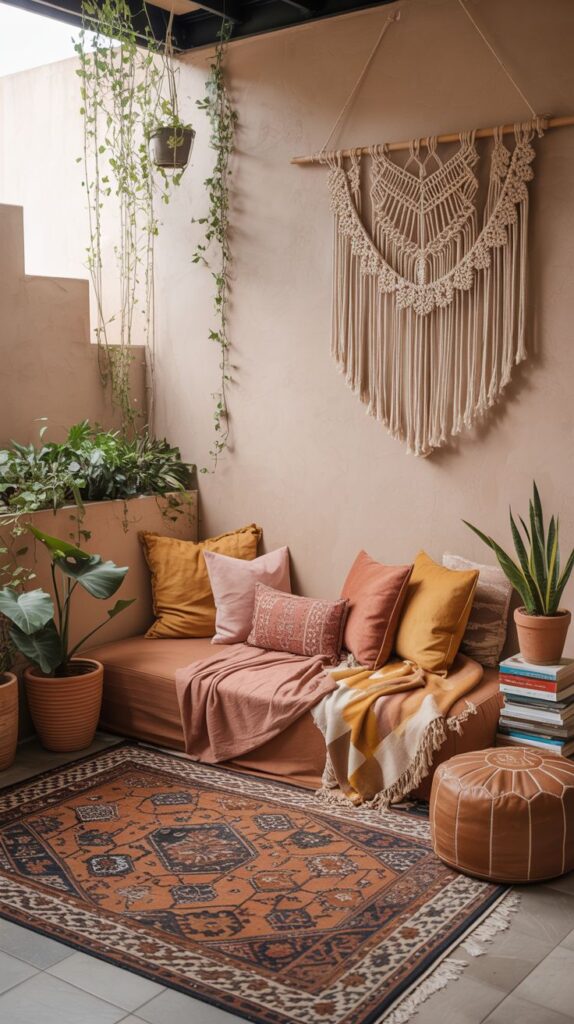
This spiritual space is for the free-spirited, the traveler, and the collector of stories and experiences. It rejects rigid rules in favor of a rich, layered, and personal aesthetic. The Bohemian Wanderer’s Alcove tells a story—your story. It’s filled with treasures from travels (real or imagined), handmade items, and a joyful mix of patterns and textures that reflect a life lived fully and creatively. This is a sanctuary of self-expression, where perfection is found in the beautifully imperfect.
Embrace a warm, earthy color palette as your base—terracotta, mustard yellow, dusty pink, and olive green. Then, layer with abandon. Mix and match patterns with confidence: kilim rugs, Moroccan wedding blankets, and Indian block-print pillows can all live happily together. Textiles are key; think macrame wall hangings, tasseled throws, and gauzy linen curtains that billow in the breeze. Furniture should be relaxed and low to the ground, like floor cushions, a vintage rattan chair, or a worn leather pouf. And, of course, fill the space with plants—hanging baskets of ivy and sprawling succulents in terracotta pots are a must.
The charm of the Bohemian Wanderer’s Alcove lies in its authenticity. It’s a living scrapbook of your journey. Every object has a memory attached, and the combined effect is a space that feels vibrant, warm, and uniquely you. It’s a room that celebrates freedom, creativity, and the beauty of a life woven from diverse and colorful threads.
6. The Creative Muse’s Atelier
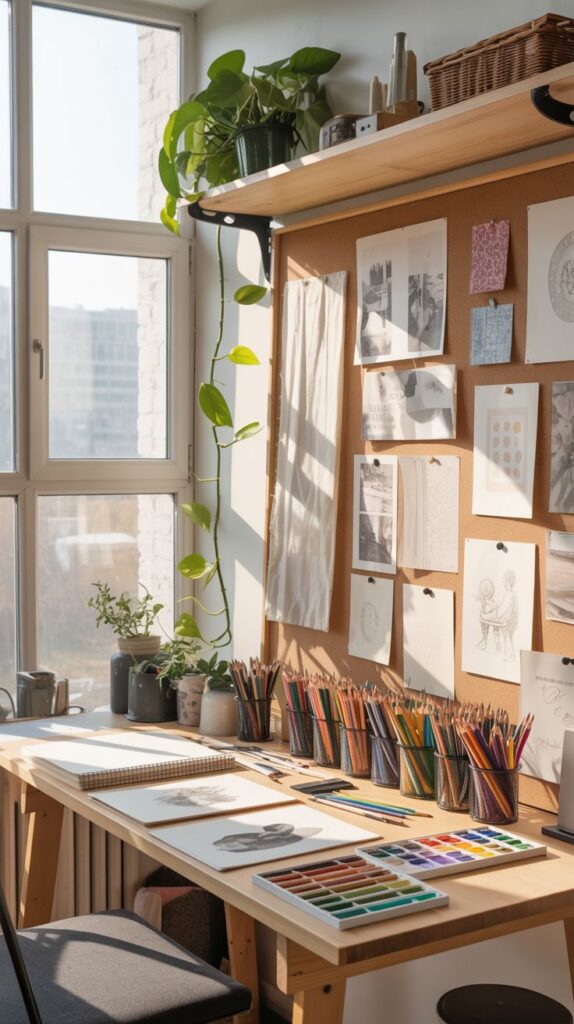
For many, spirituality is found in the act of creation. This room is a sacred workshop for the artist, writer, musician, or maker. It’s a space designed to invite inspiration and provide the freedom to be messy, to experiment, and to bring new ideas into the world. The Creative Muse’s Atelier is less about quiet contemplation and more about active, joyful expression. It’s an organized yet accessible space where your tools are at hand and your imagination is given permission to run wild.
The design should be practical yet inspiring. Good, clear lighting is paramount—a mix of strong natural light and excellent task lighting. Walls can be a neutral canvas of white or light grey, allowing the colors of your work to pop, or you could dedicate one wall as a massive corkboard or chalkboard for brainstorming. Storage should be open and inspiring—think jars of colorful pens, shelves of beautiful paper, or a guitar hanging on the wall as a piece of functional art. The furniture is utilitarian but comfortable: a large, sturdy work table, an ergonomic chair, and a soft rug to warm the space.
This atelier is a partnership between you and your muse. It’s a room that respects the creative process by providing both the structure and the freedom it requires. By dedicating a space to your craft, you are honoring that part of your spirit. It becomes a powerful incubator for ideas, a place where the spiritual practice of creation can be performed with joy and focus.
7. The Tranquil Waterside Escape
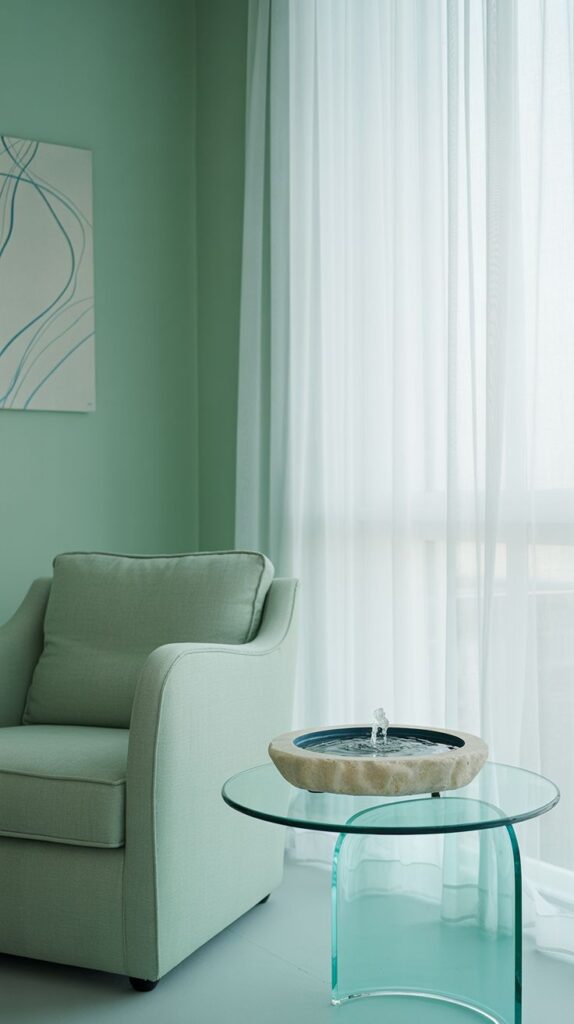
This vision is for the soul soothed by the element of water. It’s a space designed to evoke the serenity of a calm lake, a gentle stream, or a misty seaside morning. Water represents flow, purification, and emotional depth, and this room harnesses those qualities to create a deeply calming and cleansing environment. It’s a sanctuary for washing away stress, finding emotional balance, and encouraging a state of fluid grace.
The color palette is a direct reflection of water in all its forms: soft blues, seafoam green, misty grey, and sandy beige, with crisp white accents like sea spray. Textures should be smooth and flowing, reminiscent of water-worn stones and sand. Think a smooth-to-the-touch silk throw, polished glass decor, and curtains made of a light, sheer fabric that ripples in a breeze. A small, elegant indoor fountain can provide the gentle, meditative sound of running water. Artwork could feature abstract seascapes or photography of tranquil water scenes.
The Tranquil Waterside Escape is a haven of peace that helps you go with the flow of life. It’s a space that encourages you to release what no longer serves you, just as a river carries away debris. By surrounding yourself with the visual and auditory cues of water, you create a powerful environment for emotional healing, reflection, and serene contemplation.
8. The Sun-Drenched Solarium of Stillness
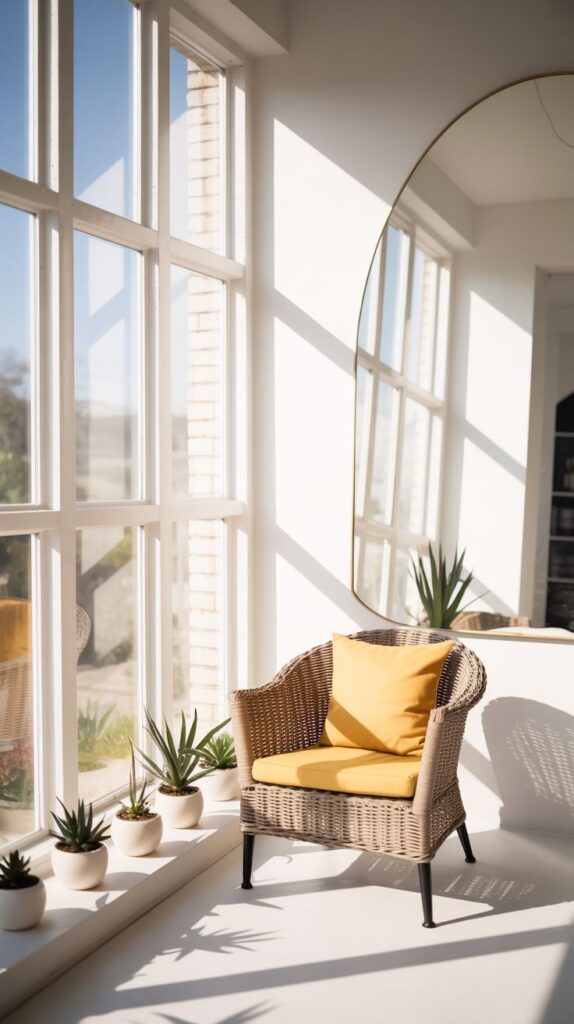
This spiritual room is a celebration of light, optimism, and growth. It’s for the spirit that thrives in the sun, drawing energy and positivity from its rays. This space is designed to maximize natural light, creating a bright, warm, and uplifting environment that feels like a perpetual summer morning. It’s a place for gratitude, joyful meditation, and soaking in the positive energy that light provides. Think of it as your personal greenhouse for cultivating happiness.
The design is all about enhancing and celebrating sunlight. Keep walls and ceilings painted a bright, clean white to reflect light around the room. Window treatments should be minimal or non-existent; if privacy is needed, opt for translucent blinds or sheer linen curtains. Furniture can be light in both color and scale—think natural wood, rattan, or wicker. Incorporate reflective surfaces like a beautifully framed mirror or a few tasteful glass or metallic accents to bounce light. This is also a perfect home for sun-loving plants like succulents, cacti, or a vibrant flowering plant like an orchid.
The Sun-Drenched Solarium of Stillness is a powerful antidote to darkness and lethargy. It’s a space that physically and metaphorically “lightens” your mood. Starting your day with a few moments of quiet in this room can set a positive tone, filling you with warmth and energy. It’s a sanctuary that honors the life-giving power of the sun and its ability to help our spirits grow and blossom.
